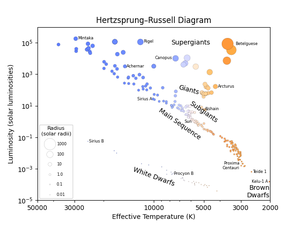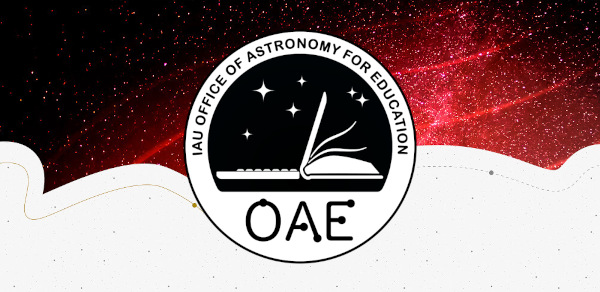Glossary term: Stellar Evolution
Description: Stellar evolution describes the aging of stars and how they change over their life cycle. Unlike in evolutionary biology, stellar evolution does not refer to changes in traits between different generations of stars.
Stars spend most of their life on the main sequence stage of stellar evolution, fusing hydrogen into helium in their cores and releasing energy. As a star ages and starts to run out of hydrogen in its core, the core will contract and may become hot enough to start helium fusion. Depending on the mass of the star, this can lead to the star evolving into a giant or supergiant. In some giants and supergiants, fusion produces heavier and heavier elements.
Stars with initial masses between a half and eight times the mass of our Sun will end up with cores of carbon, oxygen, and/or neon, while hydrogen and helium fusion continues in shells around the core, providing them with a layered onion-like structure. They will eventually lose their outer layers, which go on to form a planetary nebula, leaving only the core as a small, bright white dwarf.
Stars weighing more than eight solar masses continue fusing heavier elements until the nuclei in their core have fused to iron. Further fusion then can liberate no additional energy. This triggers a supernova explosion, which leaves behind either a very compact neutron star or, for very massive stars, a black hole.
Both planetary nebulae and supernova explosions eject matter from stars into the interstellar medium. At certain other phases of their evolution, many stars also eject mass by stellar winds, extreme pulsations, or explosions. The ejected matter has been enriched in heavy elements as a result of the nuclear fusion and, in the case of an explosion, nuclear reactions during the explosion itself. This enriched material may be incorporated into future generations of stars.
The evolution of stars throughout all these phases can be altered by interaction with a companion in a multiple star system.
Related Terms:
- Black Hole
- Main Sequence
- Neutron Star
- Nuclear Fusion
- Planetary Nebula
- Stellar Remnants
- Supernova
- White Dwarf
- Interstellar Medium
See this term in other languages
Term and definition status: This term and its definition have been approved by a research astronomer and a teacher
The OAE Multilingual Glossary is a project of the IAU Office of Astronomy for Education (OAE) in collaboration with the IAU Office of Astronomy Outreach (OAO). The terms and definitions were chosen, written and reviewed by a collective effort from the OAE, the OAE Centers and Nodes, the OAE National Astronomy Education Coordinators (NAECs) and other volunteers. You can find a full list of credits here. All glossary terms and their definitions are released under a Creative Commons CC BY-4.0 license and should be credited to "IAU OAE".
Related Diagrams
Hertzsprung-Russell diagram
Credit: IAU OAE/Niall Deacon
License: CC-BY-4.0 Creative Commons Attribution 4.0 International (CC BY 4.0) icons
Related Activities
Star in a Box: Advanced
astroEDU educational activity (links to astroEDU website) Description: Explore the life-cycle of stars with Star in a Box activity.License: CC-BY-4.0 Creative Commons Attribution 4.0 International (CC BY 4.0) icons
Tags: Hands-on , Interactive , Software Age Ranges: 10-12 , 12-14 , 14-16 , 16-19 Education Level: Middle School Areas of Learning: Technology-based Costs: Low Cost Group Size: Group Skills: Communicating information , Constructing explanationsStar in a Box: High School
astroEDU educational activity (links to astroEDU website) Description: Explore the life-cycle of stars with Star in a Box activity.License: CC-BY-4.0 Creative Commons Attribution 4.0 International (CC BY 4.0) icons
Tags: Hands-on , Interactive , Software Age Ranges: 10-12 , 12-14 , 14-16 , 16-19 Education Level: Middle School Areas of Learning: Technology-based Costs: Low Cost Group Size: Group Skills: Communicating information , Constructing explanations










